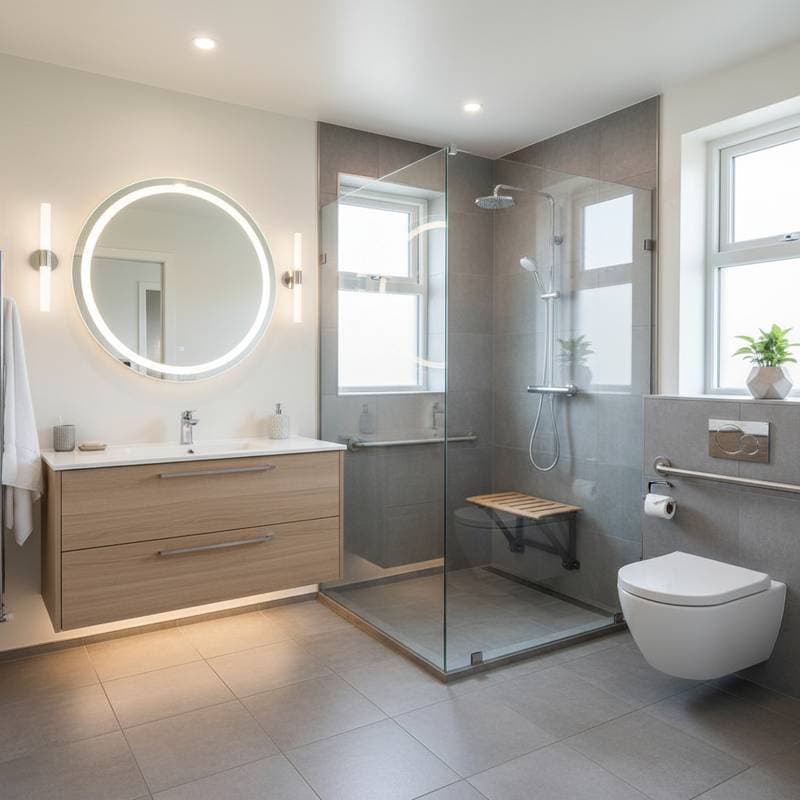Why Japandi Wet Rooms Create a More Spa-Like Experience Than Traditional Showers
Homeowners often seek ways to transform their bathrooms into serene retreats. Japandi wet rooms achieve this by merging Japanese minimalism with Scandinavian coziness. These designs deliver clean lines, natural materials, and open layouts that elevate daily routines to luxurious levels. Achieving such a space requires thoughtful planning, yet it remains accessible across various budgets.
This article explores the principles behind Japandi wet rooms and their advantages over conventional showers. It covers design elements, practical benefits, and implementation strategies to help readers envision and execute their own transformations.
The Essence of Japandi Design in Wet Rooms
Japandi style emphasizes harmony between simplicity and comfort. Japanese influences contribute clean, uncluttered forms and a focus on mindfulness. Scandinavian elements introduce warm textures and natural materials, fostering a sense of hygge or coziness.
In a wet room application, this fusion eliminates barriers typical of traditional showers. The space becomes a unified area where the shower integrates seamlessly with the rest of the bathroom. This openness promotes relaxation and expands the perceived size of the room.
Advantages of Wet Rooms Over Traditional Showers
Wet rooms offer superior functionality and aesthetics compared to enclosed showers. The absence of curbs or trays creates a continuous floor plane, which enhances spatial flow. Even compact bathrooms benefit from this design, appearing more expansive and inviting.
Cleaning proves simpler in wet rooms due to fewer crevices and seams. Water drains efficiently across sloped floors, reducing moisture buildup and mold risks. Accessibility improves as well, with level entry points that accommodate all users, including those with mobility challenges.
Advanced waterproofing solutions ensure durability. Systems such as Schluter membranes or Wedi boards provide reliable barriers against leaks. These materials allow for confident use without constant worry about water damage.
Conversion costs vary based on scope. A straightforward retrofit, utilizing existing plumbing, begins around $3,000. For a premium setup with custom features, budgets approach $10,000, yet the investment yields enduring value through enhanced usability and appeal.
Selecting Materials for Authentic Japandi Appeal
Materials form the foundation of a Japandi wet room's tranquil atmosphere. Neutral palettes dominate, with earth tones and subtle contrasts creating balance. Textures range from smooth surfaces to subtle grains, evoking nature without overwhelming the space.
For flooring, large-format porcelain tiles replicate stone or concrete effectively. Options like sealed travertine or slate add authenticity for higher-end projects. These choices withstand moisture while contributing to the room's serene vibe.
Wall treatments blend matte plasters with wood elements, such as vertical slats or bamboo accents. Fixtures feature understated finishes like brushed brass or matte black, maintaining clean profiles. Incorporate functional details, including teak benches or built-in shelves, to support storage and introduce organic warmth.
Budget-conscious alternatives include peel-and-stick panels mimicking premium surfaces. These install quickly and suit temporary upgrades, allowing renters to achieve a polished look affordably.
Optimizing Lighting and Layout for Serenity
Effective lighting enhances the spa-like quality of a Japandi wet room. Layered approaches combine ambient, task, and accent illumination to suit different needs. This strategy creates depth and mood, transforming the space at various times of day.
Install recessed ceiling fixtures for overall brightness. Add LED strips beneath vanities or benches for subtle glows. Highlight textured walls with directional spots to emphasize material qualities.
A warm color temperature, around 2700K, promotes relaxation. Such setups not only illuminate but also amplify the calming effects of Japandi elements.
Layout planning ensures efficiency and flow. Position the shower area to avoid obstructing movement, with drains placed strategically for even water dispersal. Integrate storage solutions that preserve openness, such as recessed niches or wall-mounted units. Thoughtful zoning maintains the room's minimalist ethos while supporting daily practicality.
Implementing Japandi on a Budget
Creating a Japandi wet room demands creativity rather than unlimited funds. Start with DIY waterproofing kits from hardware retailers, which simplify preparation for floors and walls. These tools enable amateurs to achieve professional results.
Source tiles from discount outlets or clearance sales to secure quality at reduced prices. Repurpose salvaged wood for vanities or accents, applying sealants to ensure water resistance. Simple upgrades, like installing a rainfall showerhead, introduce luxury without major overhauls.
One project demonstrated these methods by revamping a space for under $1,500. The outcome rivaled high-end designs, proving that strategic choices deliver impressive transformations.
Simplifying Maintenance in Wet Room Designs
Japandi wet rooms excel in long-term upkeep. Seamless surfaces minimize areas where dirt accumulates, streamlining cleaning routines. A daily wipe with a squeegee suffices for most maintenance, preserving the pristine appearance.
For natural stone elements, apply a gentle cleaner weekly to prevent residue buildup. The design's integrity reduces repair needs, avoiding issues like cracked bases or faulty seals common in traditional setups. This practicality ensures the space remains enjoyable and cost-effective over time.
Embracing the Daily Benefits of Your Wet Room
A completed Japandi wet room enriches routine moments. The open design invites a sense of calm, with water sounds and natural textures engaging the senses. Mornings begin with renewed tranquility, setting a positive tone for the day.
The versatility of the style supports future adaptations, from adding soaking tubs to refreshing accents. For homeowners considering property value, these features attract buyers seeking modern, inclusive bathrooms. The craftsmanship conveys intentionality, enhancing market appeal.
Steps to Design and Install Your Wet Room
Begin the process by assessing your bathroom's dimensions and identifying the wet zone. Evaluate current plumbing to determine retrofit feasibility. Select waterproofing compatible with your experience level.
Consult professionals if needed, providing clear references and priorities like maintenance ease. Plan meticulously to align vision with reality. Through deliberate steps, a Japandi wet room emerges as a timeless sanctuary tailored to personal needs.










